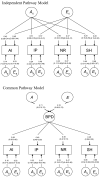Genetic covariance structure of the four main features of borderline personality disorder
- PMID: 20695804
- PMCID: PMC3705216
- DOI: 10.1521/pedi.2010.24.4.427
Genetic covariance structure of the four main features of borderline personality disorder
Abstract
The patient population of borderline personality disorder (BPD) is heterogeneous; many different combinations of BPD symptoms can lead to a BPD diagnosis. We investigated to what extent the covariance among four main components of BPD is explained by shared genetic and environmental factors. Using an extended twin design, multivariate genetic models were applied to the scales of the PAI-BOR, a self-report questionnaire tapping four main features of BPD (affective instability, identity problems, negative relationships, and self-harm). Data on the four BPD scales were available for 5,533 twins and 1,202 siblings from the Netherlands, Belgium, and Australia. The correlations among the scales ranged from 0.23 to 0.50 and were best explained by a genetic common pathway model. This model specifies that genes and environment influence the covariance between four main features of BPD in qualitatively similar ways, through a single latent factor representing the BPD construct. The heritability of the latent BPD factor was 51% and the remainder of its variance was explained by unique environmental influences. For each BPD scale, except self-harm, around 50% of its variance was explained by the latent BPD factor. The remaining variance for each of the four scales was explained by genetic (4% for affective instability to 20% for self-harm) and environmental (38% for negative relationships to 67% for self-harm) factors that were specific to each scale.
Figures


References
-
- Akaike H. Factor-analysis and AIC. Psychometrika. 1987;52:317–332.
-
- American Psychiatric Association . Diagnostic and statistical manual of mental disorders. 4th ed. American Psychiatric Press; Washington, DC: 2000. text revision.
-
- Bandelow B, Krause J, Wedekind D, Broocks A, Hajak G, Ruther E. Early traumatic life events, parental attitudes, family history, and birth risk factors in patients with borderline personality disorder and healthy controls. Psychiatry Research. 2005;134:169–179. - PubMed
-
- Becker DF, McGlashan TH, Grilo CM. Exploratory factor analysis of borderline personality disorder criteria in hospitalized adolescents. Comprehensive Psychiatry. 2006;47:99–105. - PubMed
-
- BellPringle VJ, Pate JL, Brown RC. Assessment of borderline personality disorder using the MMPI-2 and the personality assessment inventory. Assessment. 1997;4:131–139.
Publication types
MeSH terms
Grants and funding
LinkOut - more resources
Full Text Sources
Research Materials

